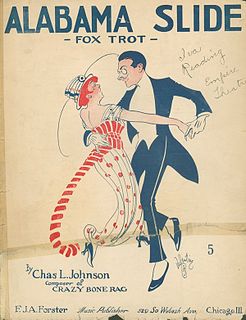Related Research Articles

Viennese waltz is a genre of ballroom dance. At least four different meanings are recognized. In the historically first sense, the name may refer to several versions of the waltz, including the earliest waltzes done in ballroom dancing, danced to the music of Viennese waltz.

The foxtrot is a smooth, progressive dance characterized by long, continuous flowing movements across the dance floor. It is danced to big band music. The dance is similar in its look to waltz, although the rhythm is in a 4
4 time signature instead of 3
4. Developed in the 1910s, the foxtrot reached its height of popularity in the 1930s and remains practiced today.
This is a list of dance terms that are not names of dances or types of dances. See List of dances and List of dance style categories for those.

In ballroom dancing, directions of progressive movement, in particular, directions of steps, can be indicated either in relation to the room or in relation to the body position. Directions of turns, although there are only two of them, may also be indicated in several ways.

The quickstep is a light-hearted dance of the standard ballroom dances. The movement of the dance is fast and powerfully flowing and sprinkled with syncopations. The upbeat melodies that quickstep is danced to make it suitable for both formal and informal events. Quickstep was developed in the 1920s in New York City and was first danced by Caribbean and African dancers. Its origins are in combination of slow foxtrot combined with the Charleston, a dance which was one of the precursors to what today is called swing dancing.

Box step is a basic dance step named after the pattern it creates on the floor, which is that of a square or box. It is used in a number of American Style ballroom dances: rumba, waltz, bronze-level foxtrot. While it can be performed individually, it is usually done with a partner. This is the most common dance step in the waltz. In international standard dance competition, there is a similar step called closed change.

The Walking Boston, sometimes designated the One Step Waltz, is a very simple dance in which many graceful figures may be introduced. It is done to the same music as the Hesitation Waltz and Dream Waltz.
Samba de Gafieira is a partner dance to various Brazilian samba musical rhythms. Unlike street and club forms of Brazilian samba, it evolved as a ballroom dance.
The feather or feather step is a dance figure in the International Style foxtrot. Depending on a syllabus, it consists of three or four steps, with the third step done outside the lady with a slight turn in the body position to the right.

Waltz is one of the five dances in the Standard category of the International Style ballroom dances. It was previously referred to as slow waltz or English waltz.
V6 is a silver level dance pattern of the quickstep International Standard Ballroom dance syllabus. The couple moves diagonally to the center (DC) and then diagonally to the wall (DW), thus sweeping a V-shape on the floor.

Contra body movement is used in ballroom dances, such as waltz, foxtrot, tango, and quickstep. It comprises turning the body against the movement of the legs: either moving forward with the right foot and the left hip and shoulder, or vice versa.
The whisk is a ballroom dance step used in the waltz and American style Viennese waltz. It is one of several ways to get into promenade position and is used to turn dancers around corners or change their direction on the dance floor. It can be performed after a reverse turn.
A natural turn is a dance step in which the partners turn around each other clockwise. Its near-mirror counterpart is the reverse turn, which is turning to the counter-clockwise.
The impetus is a ballroom dance step used in the waltz, foxtrot or quickstep. The open impetus is one of several ways to get into promenade position and is used to turn dancers around corners or change their direction on the dance floor. It is often performed after a natural turn.
The Telemark is a ballroom dance step; in waltz competition, it is in the Silver syllabus. Telemarks are reverse turns where the follower does a heel turn as the leader travels around her. There are similar Telemarks in foxtrot and quickstep.
A wing is a ballroom dance move, in the silver syllabus of competition waltz. It is a transitional movement that repositions the follower to the leader's left side. Thus, while many dance moves can precede a wing, only a reverse movement can follow a wing, such as a reverse turn, double reverse spin, Telemark, fallaway reverse, or drag hesitation.
There are several types of lock step in waltz dancing, including International Standard waltz. A "lock step" is when the moving foot approaches to the standing foot and crosses in front of or behind it, creating a "check" position.
The chassé is a waltz ballroom dance figure. Like chassés in other dances, it involves a triple-step where one foot "chases" the other in a "step-together-step" pattern. It is derived from a ballet step.
References
- ↑ The Ballroom Technique; Moore, Alex (2006). Published by ISTD ASIN: B000PH46KI.
- 1 2 BallroomDancers.com